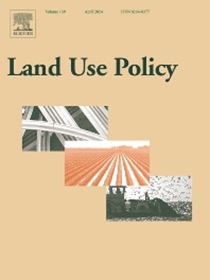Dissecting forest transition: Contribution of mature forests, second-growth forests and tree plantations to tree cover dynamics in the tropics
IF 5.9
1区 社会学
Q1 ENVIRONMENTAL STUDIES
引用次数: 0
Abstract
Forest Transition (FT) is a theoretical framework for understanding tree cover changes but often overlooks differences within countries, across forest types (e.g., second-growth forests, tree plantations replacing natural forests), regions, and climates. We quantified tropical tree cover dynamics across eight regions in four tropical countries, examining how these patterns relate to FT and how they vary between climates and forest types. Each country represented a different stage in the FT trajectory. We combined Landsat-derived time-series from 1990 to 2020 with Sentinel-2-based land cover classification to distinguish between mature natural forests (MF), second-growth forests (SF), tree plantations (TP), and their dynamics. During this period, 50 % of MF was lost, while tree cover gains averaged 16 % across regions; SF contributed 23 % and TP 12 % of total tree cover by 2020. SF steadily increased, yet its average lifespan was only 10 years, limiting its ecological contributions compared to MF. The studied regions followed the theoretical FT trajectory: the Ghanaian regions were in early transition (pre-inflection), Mexican regions were in late transition (pre-inflection), and the Australian and Brazilian (São Paulo state) regions were in post-transition (post-inflection). Evaluating FT while including or excluding TP results in different conclusions about the FT trajectory of a region or country. MF was lower in dry (from 55 % in the 1990s to 23 % in 2020) than in wet (from 73 % in the 1990s to 35 % in 2020) forest regions. SF gains were higher in dry (31 %) than in wet (23 %) regions, though SF increases did not compensate for MF loss, resulting in reduced biodiversity and ecological functioning. Hence, halting deforestation and protecting young forests are equally crucial. Evaluating FT excluding TP and quantifying SF persistence may have far-reaching consequences for how to evaluate tree cover by not only evaluating tree cover quantity, but also tree cover quality. Our findings can inform policymakers to design smart policy mixes that sequence the right policy instruments at the right time. Local people must participate in forest restoration strategies and issues of equity, justice and power imbalances must be addressed to facilitate FT. Dissecting FT increases our understanding of the underlying forest cover dynamics, which can lead to better policies for protecting local people`s livelihoods, halt deforestation, and facilitate FT to restore the natural world upon which people`s lives and society depend.
剖析森林变迁:热带地区成熟森林、次生林和人工林对树木覆盖动态的贡献
森林转型(FT)是理解树木覆盖变化的理论框架,但往往忽略了国家内部的差异,包括森林类型(如次生林、人工林取代天然林)、地区和气候的差异。我们量化了四个热带国家八个地区的热带树木覆盖动态,研究了这些模式与FT的关系,以及它们在气候和森林类型之间的变化。每个国家都代表着英国《金融时报》发展轨迹的不同阶段。我们将1990 - 2020年landsat时间序列与基于sentinel -2的土地覆盖分类相结合,以区分成熟天然林(MF)、次生林(SF)和人工林(TP)及其动态。在此期间,森林覆盖率损失了50% %,而各区域的树木覆盖率平均增加了16% %;到2020年,SF和TP分别占总树木覆盖率的23. %和12. %。SF稳步增长,但其平均寿命仅为10年,与MF相比,其生态贡献有限。研究区域遵循理论FT轨迹:加纳地区处于早期转型(前拐点),墨西哥地区处于后期转型(前拐点),澳大利亚和巴西(圣保罗州)地区处于后转型(后拐点)。在包括或不包括TP的情况下评估FT,会对一个地区或国家的FT轨迹得出不同的结论。干旱区(从1990年代的55 %到2020年的23 %)的MF低于湿林区(从1990年代的73 %到2020年的35 %)。干旱区顺丰度的增加(31% %)高于湿区(23% %),但顺丰度的增加并不能弥补MF的损失,导致生物多样性和生态功能的降低。因此,停止砍伐森林和保护幼林同样至关重要。对除去TP的FT进行评价,并对森林覆盖度持续性进行量化,可能会对如何通过评价树木覆盖数量和质量来评价树木覆盖产生深远的影响。我们的研究结果可以为政策制定者提供信息,以设计明智的政策组合,在正确的时间安排正确的政策工具。当地人民必须参与森林恢复战略,必须解决公平、正义和权力不平衡问题,以促进森林覆盖率的提高。剖析森林覆盖率有助于我们了解潜在的森林覆盖动态,从而制定更好的政策来保护当地人民的生计,停止森林砍伐,并促进森林覆盖率恢复人们生活和社会所依赖的自然世界。
本文章由计算机程序翻译,如有差异,请以英文原文为准。
求助全文
约1分钟内获得全文
求助全文
来源期刊

Land Use Policy
ENVIRONMENTAL STUDIES-
CiteScore
13.70
自引率
8.50%
发文量
553
期刊介绍:
Land Use Policy is an international and interdisciplinary journal concerned with the social, economic, political, legal, physical and planning aspects of urban and rural land use.
Land Use Policy examines issues in geography, agriculture, forestry, irrigation, environmental conservation, housing, urban development and transport in both developed and developing countries through major refereed articles and shorter viewpoint pieces.
 求助内容:
求助内容: 应助结果提醒方式:
应助结果提醒方式:


